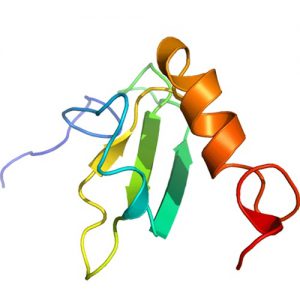How well do you know chemokines?

Human Chemokine CXCL5, available from the lab of Dr. Brian F. Volkman at the Medical College of Wisconsin.
Chemokines are signaling proteins secreted by cells, whose main function is to act as a chemoattractant to guide the migration of nearby cells. Part of the cytokine class of molecules, chemokines are important components of the immune system, forming a complex regulatory network that connects the innate and adaptive immune systems. Chemokines bind G protein-coupled receptors located on the surface of leukocytes, or white blood cells, where they serve as primary mediators of inflammation while also directing the homing and maturation of lymphocytes.
Although the activity and function of chemokines has been known for some time, there are some very interesting facts about this critical class of signaling molecule. How well can you answer the questions below?
- Where did chemokines get their name?
Chemokines were named based on the Greek term “kinos”, meaning movement. “Chemo” was included since the proteins elicit a chemotactic response from nearby cells. Chemotaxis is the movement of cells or organisms in response to chemical signals. - How many chemokines are there?
Approximately 50 chemokines have been discovered to date. No chemokines have been identified in invertebrate animals, although chemokines have been found in some viruses, some bacteria and all vertebrates. - How are chemokines similar?
Chemokines all share some basic characteristics. First, they have a mass between 8-10 kilodaltons. In addition, they share a very similar three-dimensional shape due to the presence of four conserved cysteine residues in each chemokine. Each chemokine is produced as a pro-peptide from which approximately 20 amino acids are cleaved from the mature form during secretion. - How are chemokines different?
Different chemokines attract different white blood cell types. Thus, a subset of chemokines attract monocytes/macrophages, a different group attracts neutrophils, and still others attract T cells, eosinophils or mast cells. In addition, chemokines are located in different parts of the body with different functions. Examples include:- Human Chemokine CCL20/MIP-3 alpha, which is strongly chemotactic for lymphocytes and weakly attracts neutrophils. It is implicated in the formation and function of mucosal lymphoid tissues.
- Human Chemokine CXCL12/SDF-1 alpha, which is strongly chemotactic for lymphocytes. It directs hematopoietic cell migration and large blood vessel formation during embryogenesis, as well as plays a key role in angiogenesis during adulthood.
- Human Chemokine CXCL5, which induces chemotactic migration in neutrophils. It is expressed in monocytes, platelets, endothelial cells and mast cells.
- What are the clinical applications of chemokines?
Chemokines were originally discovered for their role in inflammation, but subsequent research has shown that chemokine signaling is involved in many other processes, including embryonic development, angiogenesis and wound healing. Chemokines have also been implicated in various diseases, such as cancer, autoimmune disorders and diabetes. In addition, they’ve been shown to play a role in HIV infection by helping to modulate co-receptor expression required for HIV to enter host cells. Various chemokines have been shown to increase pathogenesis of HIV while others have been shown to inhibit infection.
Do you work in this area of research? Check out our selection of cytokines and chemokines, available direct from leading academic laboratories. You may also be interested in our full list of immunology reagents, including the LUVA human mast cell line, neutrophil imaging agent or lymphocyte cell lines.


